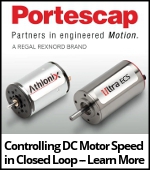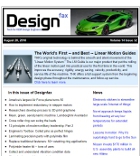 |
| January 07, 2025 | Volume 21 Issue 01 |
Motion Control News & Products
Designfax weekly eMagazine
Archives
Partners
Manufacturing Center
Product Spotlight
Modern Applications News
Metalworking Ideas For
Today's Job Shops
Tooling and Production
Strategies for large
metalworking plants
Versatile Transport System: Turbocharge conveyance
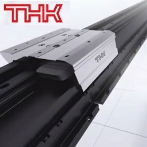 THK's Versatile Transport System is a high-mix production solution that will keep your production line moving. Its linear motor drive enables high-speed operations, and processing can be performed directly on top of the system's freely recirculating sliders. This highly precise, modular system has many unique features, including easily adjustable stop positions, flex layouts with path splitting and parallelization, and easy addition/subtraction of extension pieces.
THK's Versatile Transport System is a high-mix production solution that will keep your production line moving. Its linear motor drive enables high-speed operations, and processing can be performed directly on top of the system's freely recirculating sliders. This highly precise, modular system has many unique features, including easily adjustable stop positions, flex layouts with path splitting and parallelization, and easy addition/subtraction of extension pieces.
View the video.
Tech Tip: How to keep heavy loads balanced
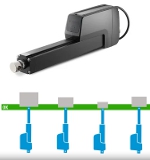 Some Thomson smart linear actuators have a position-based synchro-nization option to help manage unbalanced loads when using multiple units. The system adjusts the speed of each actuator to keep them starting, moving, and stopping synchronously, regardless of their respective load distribution. So useful. So smart.
Some Thomson smart linear actuators have a position-based synchro-nization option to help manage unbalanced loads when using multiple units. The system adjusts the speed of each actuator to keep them starting, moving, and stopping synchronously, regardless of their respective load distribution. So useful. So smart.
Learn all about this feature.
Micropositioning stages ensure high accuracy
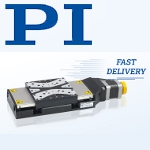 PI now offers fast delivery of the L-511 linear microposi-tioning stage, which is designed for applications requiring minimum incremental motion down to 20 nm and drive forces up to 22 lb. The L-511 can be combined to form XY or XYZ motion systems and integrated with rotary stages for enhanced flexibility. Features high-load recirculating ball bearings for exceptional durability, even under demanding, repetitive cycles. To enhance positioning accuracy and automation throughput, this stage integrates non-contact, direction-sensing optical reference point switches located at mid-travel.
PI now offers fast delivery of the L-511 linear microposi-tioning stage, which is designed for applications requiring minimum incremental motion down to 20 nm and drive forces up to 22 lb. The L-511 can be combined to form XY or XYZ motion systems and integrated with rotary stages for enhanced flexibility. Features high-load recirculating ball bearings for exceptional durability, even under demanding, repetitive cycles. To enhance positioning accuracy and automation throughput, this stage integrates non-contact, direction-sensing optical reference point switches located at mid-travel.
Learn more.
Robots think and act on the fly at moving assembly line speeds
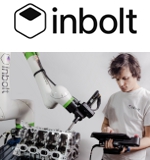 Inbolt and FANUC are launching a manufacturing breakthrough enabling FANUC robots to tackle one of the most complex automation challenges: performing production tasks on continuously moving parts at line speeds. With Inbolt's AI-powered 3D vision, manufacturers can now automate screw insertion, bolt rundown, glue application, and other high-precision tasks on parts moving down the line without costly infrastructure investments or cycle time compromises.
Inbolt and FANUC are launching a manufacturing breakthrough enabling FANUC robots to tackle one of the most complex automation challenges: performing production tasks on continuously moving parts at line speeds. With Inbolt's AI-powered 3D vision, manufacturers can now automate screw insertion, bolt rundown, glue application, and other high-precision tasks on parts moving down the line without costly infrastructure investments or cycle time compromises.
Learn more.
Best high-speed rotary bearing in THK history
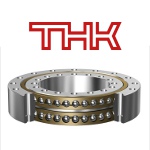 THK has developed its best-performing, high-speed rotary bearing ever: the High-Speed, Double-Row Angular Contact Ring BWH. This rotary bearing has balls aligned inside a cage between the inner and outer rings and is part of the THK Rotary Series, along with the cross-roller ring. The main features of this product are its ability to receive loads in all directions as well as its high rigidity and rotational accuracy, which are equal to that of cross-roller rings. By adopting a new structure to change the rolling elements from rollers to balls, this product achieves the greatest high-speed performance ever offered by THK.
THK has developed its best-performing, high-speed rotary bearing ever: the High-Speed, Double-Row Angular Contact Ring BWH. This rotary bearing has balls aligned inside a cage between the inner and outer rings and is part of the THK Rotary Series, along with the cross-roller ring. The main features of this product are its ability to receive loads in all directions as well as its high rigidity and rotational accuracy, which are equal to that of cross-roller rings. By adopting a new structure to change the rolling elements from rollers to balls, this product achieves the greatest high-speed performance ever offered by THK.
Learn more.
Elevating tables: Precise vertical positioning in tight spaces
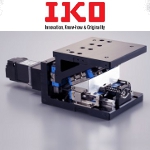 As semicon-ductors and optical components become smaller and more sophisticated, the TZ Series of precision elevating tables from IKO International provides exceptional vertical positioning accuracy in a compact size. This unit features a unique wedge mechanism guided in the vertical direction by a pair of IKO C-Lube Super MX linear motion rolling guides arranged in parallel to achieve highly precise positioning with exceptional rigidity. An optional linear encoder provides full closed loop control to achieve positioning accuracy as high as 0.005 mm, with repeatability of +/-0.001 mm.
As semicon-ductors and optical components become smaller and more sophisticated, the TZ Series of precision elevating tables from IKO International provides exceptional vertical positioning accuracy in a compact size. This unit features a unique wedge mechanism guided in the vertical direction by a pair of IKO C-Lube Super MX linear motion rolling guides arranged in parallel to achieve highly precise positioning with exceptional rigidity. An optional linear encoder provides full closed loop control to achieve positioning accuracy as high as 0.005 mm, with repeatability of +/-0.001 mm.
Learn more and get all the specs.
This cobot is all about safety around people
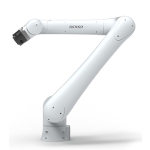 The COBOTTA PRO from DENSO Robotics is a lightweight, high-speed collaborative robot designed for communication between workers and robots while maximizing productivity. It delivers a blend of productivity and safety for both simple tasks and multi-step processes like assembly and inspection work. The 6-axis unit operates at speeds up to 2,500 mm per sec when no workers are near and slows or stops when people approach. Two models available: PRO 900 (max payload 6 kg) and PRO 1300 (max payload 12 kg). Many more functions and features.
The COBOTTA PRO from DENSO Robotics is a lightweight, high-speed collaborative robot designed for communication between workers and robots while maximizing productivity. It delivers a blend of productivity and safety for both simple tasks and multi-step processes like assembly and inspection work. The 6-axis unit operates at speeds up to 2,500 mm per sec when no workers are near and slows or stops when people approach. Two models available: PRO 900 (max payload 6 kg) and PRO 1300 (max payload 12 kg). Many more functions and features.
Learn more.
Powerful, pull-type clapper solenoids handle myriad jobs
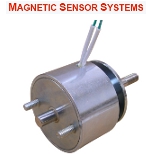 New powerful, low-profile, pull-type clapper solenoids are available from Magnetic Sensor Systems (MSS). Applications include valve control, locks, starters, ventilators, clamping, sorting, appliances, tools, HVAC, brakes, clutches, switches, mixing, fire suppression systems, door controls, detent latches, and more. The S-16-264 Series of 17 Pull-Type Clapper Solenoids have ampere turns (windings) adjusted to meet the specific force and duty cycle requirements of your application. They provide up to 130 lb (578 N) of force.
New powerful, low-profile, pull-type clapper solenoids are available from Magnetic Sensor Systems (MSS). Applications include valve control, locks, starters, ventilators, clamping, sorting, appliances, tools, HVAC, brakes, clutches, switches, mixing, fire suppression systems, door controls, detent latches, and more. The S-16-264 Series of 17 Pull-Type Clapper Solenoids have ampere turns (windings) adjusted to meet the specific force and duty cycle requirements of your application. They provide up to 130 lb (578 N) of force.
Get all the specs for these solenoids and other options.
Tech Tip: Belt, screw, or chain-driven actuator?
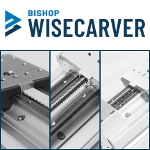 Bishop-Wisecarver provides a quick, very useful guide to help you evaluate the right drive strategy for your system: belt, screw, or chain-driven actuator. Each drive type has unique advantages and limitations, so evaluating all your options will help you find the most suitable actuator setup for your specific application needs.
Bishop-Wisecarver provides a quick, very useful guide to help you evaluate the right drive strategy for your system: belt, screw, or chain-driven actuator. Each drive type has unique advantages and limitations, so evaluating all your options will help you find the most suitable actuator setup for your specific application needs.
Read the Bishop-Wisecarver blog.
Ultra-precise linear stage -- down to 0.005 microns
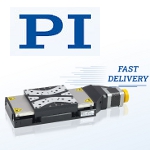 PI, a global leader in precision motion control and nanoposi-tioning, now offers fast delivery of the L-511 linear micropositioning stage, which is designed for applications requiring minimum incremental motion down to 20 nm, drive forces up to 22 lb, and multi-axis configuration options. The L-511 can be combined to form XY or XYZ motion systems and integrated with rotary stages. A variety of drive and encoder options (stepper and servo motors, rotary, and linear encoders) enable ultra-fine sensitivity. Applications include: metrology, laser processing, semiconductors, biotech, optical alignment, and advanced automation.
PI, a global leader in precision motion control and nanoposi-tioning, now offers fast delivery of the L-511 linear micropositioning stage, which is designed for applications requiring minimum incremental motion down to 20 nm, drive forces up to 22 lb, and multi-axis configuration options. The L-511 can be combined to form XY or XYZ motion systems and integrated with rotary stages. A variety of drive and encoder options (stepper and servo motors, rotary, and linear encoders) enable ultra-fine sensitivity. Applications include: metrology, laser processing, semiconductors, biotech, optical alignment, and advanced automation.
Learn more and get all the specs.
Choosing the right stepper motor: PM or hybrid?
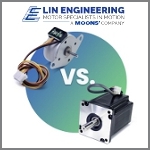 According to the experts at Lin Engineering, there are two primary types of stepper motors to consider: permanent magnet (PM) and hybrid. But which is right for your application? Both types have their advantages and disadvantages, and the choice ultimately depends on your specific requirements.
According to the experts at Lin Engineering, there are two primary types of stepper motors to consider: permanent magnet (PM) and hybrid. But which is right for your application? Both types have their advantages and disadvantages, and the choice ultimately depends on your specific requirements.
Read this informative Lin Engineering article.
New PTFE-free linear guide for precise positioning
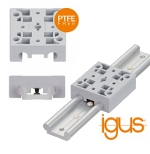 The new drylin WWP linear guide from igus features a PTFE-free locking carriage. Engineered from lubrication-free, high-performance polymers and aluminum, the guide offers a lightweight, hygienic, and low-maintenance alternative to complex mechanical and electronic adjustment systems. It is significantly more compact and lightweight than conventional recirculating ball-bearing systems. Applications include interior components in vehicles, aircraft, and furniture.
The new drylin WWP linear guide from igus features a PTFE-free locking carriage. Engineered from lubrication-free, high-performance polymers and aluminum, the guide offers a lightweight, hygienic, and low-maintenance alternative to complex mechanical and electronic adjustment systems. It is significantly more compact and lightweight than conventional recirculating ball-bearing systems. Applications include interior components in vehicles, aircraft, and furniture.
Learn more and get all the specs.
Heavy-duty gear units for mixing and agitating systems
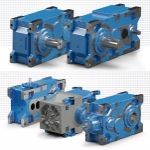 MAXXDRIVE industrial gear units from NORD DRIVE-SYSTEMS are an established drive solution for heavy-duty applications. In addition to conveying, lifting, and driving, they also play an important role in mixing and agitating systems. MAXXDRIVE units feature a compact, one-piece UNICASE housing that delivers long service life, easy maintenance, and quiet operation. Their robust design handles high axial and radial loads, achieves output torques up to 2,495,900 lb-in., and powers up to 8,075 hp.
MAXXDRIVE industrial gear units from NORD DRIVE-SYSTEMS are an established drive solution for heavy-duty applications. In addition to conveying, lifting, and driving, they also play an important role in mixing and agitating systems. MAXXDRIVE units feature a compact, one-piece UNICASE housing that delivers long service life, easy maintenance, and quiet operation. Their robust design handles high axial and radial loads, achieves output torques up to 2,495,900 lb-in., and powers up to 8,075 hp.
Learn more.
What are non-captive linear actuators?
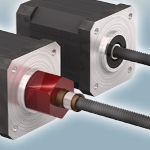 According to PBC Linear, their new non-captive linear actuators are different from the more common external versions of lead screw-driven linear actuators because they allow the lead screw to completely pass through the motor. This fundamental difference offers advantages for designs that have limited space available or for engineers looking to shrink the overall size of their design package.
According to PBC Linear, their new non-captive linear actuators are different from the more common external versions of lead screw-driven linear actuators because they allow the lead screw to completely pass through the motor. This fundamental difference offers advantages for designs that have limited space available or for engineers looking to shrink the overall size of their design package.
Read the full PBC Linear blog.
Güdel introduces Swiss-quality tracks for cobots
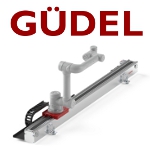 Güdel Inc. is highlighting new technologies at Automate 2025 booth #2418 that demonstrate its unmatched ability to solve automation engineering challenges. One is the Cobomover, a 7th-axis linear track purpose-built for collaborative and lightweight robots. Designed and manufactured in Switzerland, this unit extends the working range of robots up to 5 m, allowing them to operate multiple workstations and perform a variety of tasks without manual repositioning. Compatible with over 60 cobots and small traditional robots.
Güdel Inc. is highlighting new technologies at Automate 2025 booth #2418 that demonstrate its unmatched ability to solve automation engineering challenges. One is the Cobomover, a 7th-axis linear track purpose-built for collaborative and lightweight robots. Designed and manufactured in Switzerland, this unit extends the working range of robots up to 5 m, allowing them to operate multiple workstations and perform a variety of tasks without manual repositioning. Compatible with over 60 cobots and small traditional robots.
Learn more and get all the specs.
BMW to road-test revolutionary in-wheel drive motor
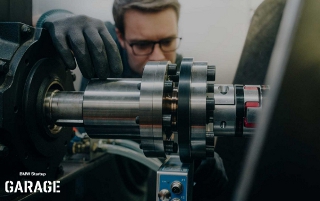
[Credit: Image by DeepDrive/Courtesy of BMW Group.]
The BMW Startup Garage, a development spinoff of BMW Group, and Munich-based motor developer DeepDrive are set to road-test a revolutionary electric motor. The concept features dual-rotor technology and is expected to enable super-efficient, powerful drives that offer plenty of range.
After a successful pilot project with promising results on the test rig, the BMW Group and DeepDrive are now planning their first field test. Various versions of the new drive will be installed into BMW Group models and their handling tested on different road conditions.
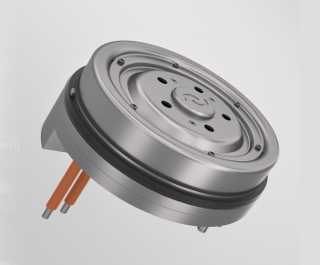
DeepDrive RM1500 integrated wheel hub motor unit. [Credit: Image courtesy of DeepDrive]
DeepDrive is a startup whose founders met while studying at TU Munich and participating in the technical university's student motorsport team. The company's innovative concept melds two electric motors into a single unit, creating an extremely compact drive that is energy efficient and has a high torque density.
In a conventional electric motor, the stator moves either an internal or an external rotor. With DeepDrive's dual-rotor concept, the stator drives both rotors simultaneously. The compact design and light weight of the unit allows for each wheel hub of an electric vehicle (EV) to have its own electric motor. The technology can also be used in a traditional, centralized drive system, where a central motor block powers the vehicle.
DeepDrive is currently developing three main in-wheel motor units for their line:
- RM1500 suitable for compact and mid-size EVs (peak power 150 kW/1,500 Nm peak torque/96.6% peak efficiency/weight 32 kg);
- RM1800 suitable for mid-size and large EVs (peak power 160 kW/1,800 Nm peak torque/97% peak efficiency/weight 35 kg); and
- RM2400 suitable for performance-focused EVs (peak power 250 kW/2,400 Nm peak torque/97% peak efficiency/weight 37 kg).
Key to the motor's operation is a revolutionary winding concept called distributed bar winding that uses 50% less magnet material, 80% less iron, and requires only simple manufacturing. Production-wise, a DeepDrive motor boasts less than 30% cost per Nm in comparison to the state-of-the-art EV motors available.
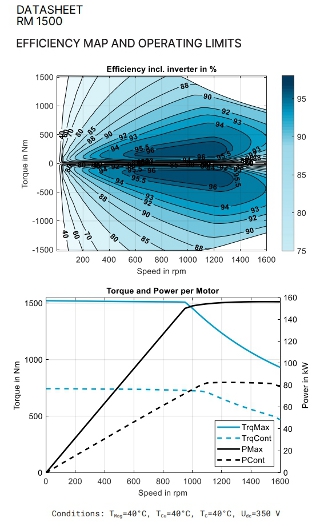
RM1500 motor unit data sheet. [Credit: Charts courtesy of DeepDrive]
For the overall DeepDrive system, the company says, "the integrated SiC MOSFET inverter, the automotive standard wheel hub unit, and the easy-to-use CAN interface make it plug & play for most electric mobility applications." An integrated drum brake is available. The units run on up to a 420-V battery supply, but 800-V versions are available. Lightweighting is also achieved because the DeepDrive units do not require a gearbox.
VIDEO: DeepDrive: Company technology breakthroughs.
VIDEO: DeepDrive: The In-Wheel Drive.
The RM1500 with integrated brake, a project realized with the help of automotive specialist Continental, was awarded "Innovation of the Year 2023" by Vehicle Dynamics International Magazine for the development of the Drive-Brake unit. The first stage of the collaboration was aimed at seeing a hydraulic brake integrated into the Drive-Brake unit. The second stage is planned to integrate the long-term dry braking system without hydraulic components into DeepDrive's innovative wheel hub drive.
According to the company, their overall motor technology boasts many technological benefits, including:
- Up to 20% efficiency increase;
- Plug-and-play with integrated inverter;
- Lowest noise emissions; and
- Lowest Total Cost of Ownership.
Alex Rosen, Deep Drive's co-founder and systems engineer, says in the company's technology video series: "Our dual-rotor, radial flux machine offers numerous advantages that set it apart from traditional electric motors. With minimal iron losses, it delivers exceptional partial load efficiency, achieving industry-leading torque density and power density while keeping material costs low.
"Our groundbreaking solution incorporates a dual-rotor, radial flux topology, integrating the benefits of an inner runner and an outer runner into a single electric machine. While the concept of a dual-rotor machine is not entirely new, our patented technology has overcome the manufacturing challenges associated with large-scale production, making it a significant breakthrough."
BMW was the first major manufacturer to get wind of DeepDrive and sign them up as technology partners. The carmaker has been intensifying collaborations with them since 2021. The startup's technology is already remarkably mature. "DeepDrive's prototype parts largely exceeded our specifications," says Karol Virsik, head of Research Vehicle Concepts and Technologies at the BMW Group. "That's really unusual at such an early stage and with a completely new technology."
"Our in-wheel motors deliver impressive performance figures, capable of generating up to 2,400 Nm of torque and 200 kW of power per wheel. This versatility enables their application across a wide range of electric vehicles, from small and compact models to large SUVs and luxury cars," says Rosen in the DeepDrive technology video series. Rosen adds that the issue of unsprung masses has been a topic of concern when it comes to in-wheel motors, but DeepDrive's lightweight units minimize unsprung masses. "The high power density of our machines allows us to reduce the size of the mechanical brake at the rear axle, or even eliminate it altogether. This ensures that the overall increase in unsprung masses when using our in-wheel motors remains negligible compared to traditional front axle-driven systems," he says.
After stints on test rigs, the proof of concept was deemed successful, delivering top results. The next step is to perform a real-world validation out on the road. The in-wheel motors will require less space and be more energy efficient, lighter, and less costly, making them an attractive option for a wide range of vehicle models -- and potentially highly scalable.
"It's alarming to realize that from plug to wheel, more than 40% of electric energy is wasted in the current state of EV technology," says Rosen. "While electric motors boast high efficiency of over 95% at high output power, the story changes when operating at lower power levels. Friction losses, iron losses, and splashing losses in the gearbox lead to a drastic reduction in efficiency during low-power operation."
"As a result, state-of-the-art drive systems struggle to maintain efficiency above 75% in everyday driving situations," says Rosen. DeepDrive believes their motor solutions can do better.
"DeepDrive has developed an exciting vision for the electric drive of the future," said Virsik. "The Startup Garage allows us to experiment with DeepDrive and work out what drives might look like in the generation after next."
You can read DeepDrive's whitepaper, "A Comprehensive Study on Different Motor Topologies Used in Passenger Car EV Segment," that has a lot more technology details, including on the special winding tech for their dual-rotor radial flux permanent magnet machine here.
Learn more at deepdrive.tech/technology.
Sources: BMW Group, BMW Startup Garage, DeepDrive
Published November 2024
Rate this article
View our terms of use and privacy policy
